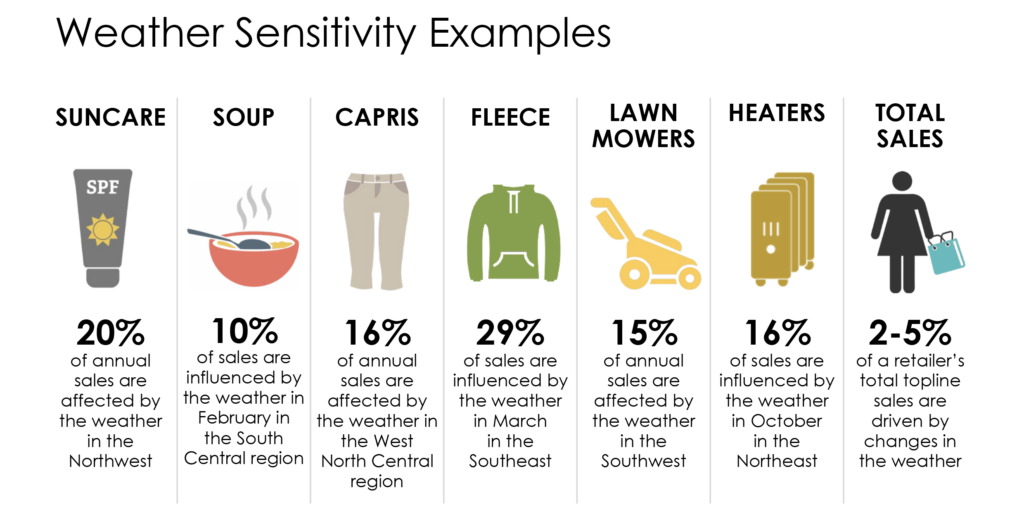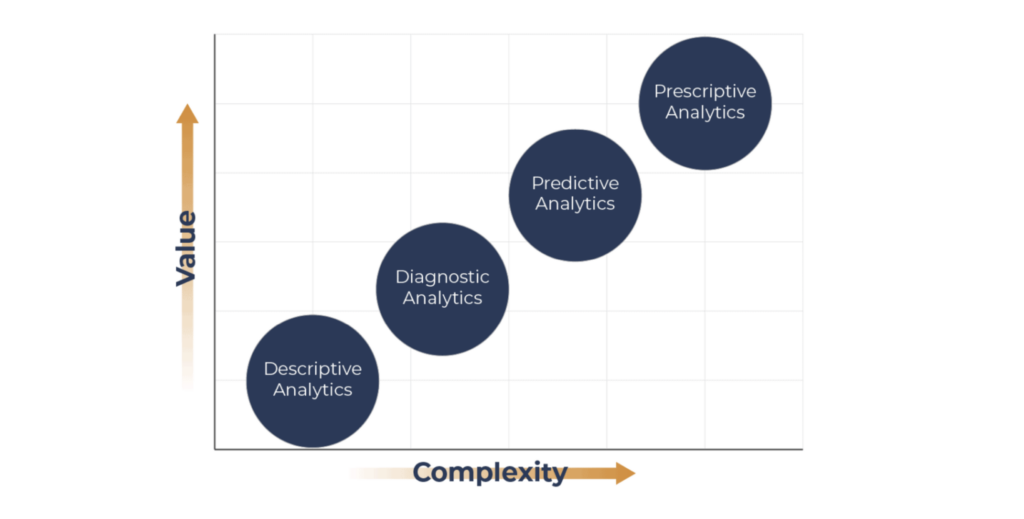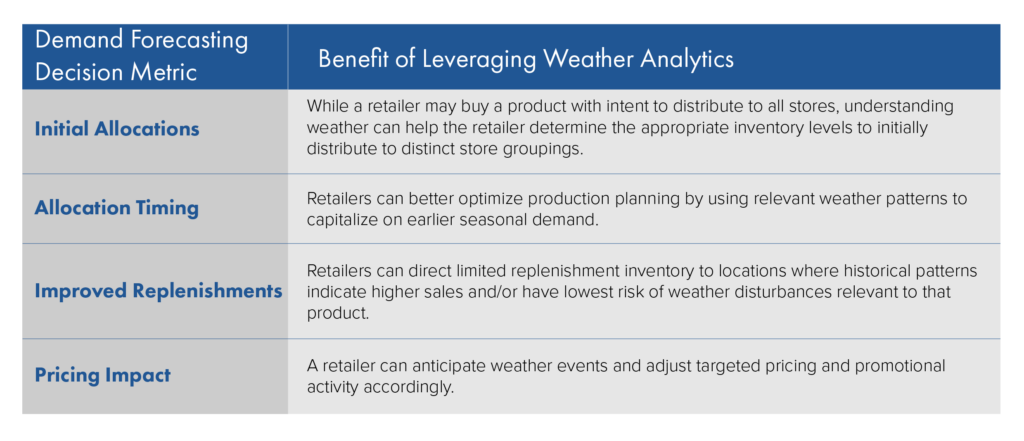Measuring and Managing the Impact of Weather on Consumer Purchasing
This article is the first in a series of thought leadership pieces co-published with Planalytics on the topic of weather analytics and the impact to consumer-centric businesses across the life sciences, consumer products, and retail industries. In this piece, we explore the wide-ranging impact of weather on consumer purchasing behaviors, including how businesses can measure and manage the impact to drive informed decision-making.
Weather consistently impacts all of us, everywhere, every day. It’s usually one of the last things we look at before going to bed at night, and the first thing we check when we get up in the morning. It affects what we do, where we go, and when we go there. Weather also has a significant impact on our shopping patterns and directly influences our purchasing. No other outside variable impacts consumer demand as frequently, directly, and meaningfully as the weather.
How Weather Affects Business Performance
Climate risk and weather-related volatility are two of the biggest issues facing businesses today. From a total retail perspective, around 3% of total global retail sales, which currently represents approximately $1 trillion dollars, is directly affected by changes in the weather every year. Despite this, weather continues to be one of the least understood, measured, and acted upon external factors that affects business performance.
Many businesses deal with weather impacts reactively, often in ‘fire drill’ mode, and mostly pay attention to large scale weather ‘events’ such as hurricanes, tornadoes, floods, etc. Yes, extreme weather events are certainly impactful and increasingly occurring. According to a recent study from the National Climate Assessment, the U.S. experiences an extreme weather event (defined as one where damages and costs top $1 billion) every three weeks. This compares to one extreme weather event every four months in the 1980s.
While extreme weather events grab news headlines, everyday weather has a much bigger financial impact on consumer purchasing. Over 90% of the volatility of weather-driven sales in retail comes from the day-in and day-out changes in weather.
The impacts of weather on consumer purchasing are nuanced and vary by retail sector, product category, time period, and individual location. This is where weather analytics comes into play, serving as an avenue for measuring and managing the impact of weather on a business.
Addressing the Impact of Weather: “If you can’t measure it, you can’t manage it’.
Analytics is the process of taking data and converting it into intelligence. There was a time when retailers were starved for data and tried to gather as much as they could. We’re now in a world where businesses are drowning in data and have entire analytics teams and departments, data scientists, analytical tools, and related technologies to manage and harness the power of their data.
Weather Data ≠ Weather Analytics
From a weather perspective, analytics is essential to understanding the impact on consumer purchasing. Weather data is a unique data set. We are acclimated to the environment we live and work in, so weather data will mean different things to people across time. For example, 50°F in Miami feels very different to the same customer experiencing the same 50°F in Minneapolis. Additionally, 50°F in April means something totally different than 50°F in August. Weather moves us out of our ‘comfort zone,’ but that zone of comfort is a subjective measure.
Weather analytics, which is the quantitative impact of weather, unlocks the impact of seasonal change and weather and translates data into a demand signal that delivers actionable intelligence, enabling businesses to proactively manage the impact of weather. Demand analytics solutions, like Planalytics, can help retailers and consumer-centric businesses measure and manage the ongoing impact of climate and weather volatility. With this data, businesses can gain insights into how sensitive and volatile demand is, providing foundational metrics for them to identify opportunities and risks across each product, time, and location intersection.

Managing the Impact of Weather
Once the impact of weather has been measured and quantified, the next step is to leverage these analytics. We can leverage a few different types of analytics to do this:

- Descriptive analytics help businesses understand WHAT happened.
- Diagnostic analytics describe WHY something happened.
- Predictive analytics envisage WHAT will happen.
- Prescriptive analytics are used to MAKE things happen.
‘Actioning’ the Weather
Weather impacts all facets of an organization. Retailers and consumer-based businesses can leverage weather-driven demand analytics to positively impact areas within the business. Common areas to implement these analytics include demand forecasting, allocation, replenishment, pricing, operations, marketing, labor scheduling, reporting, and more. Below, we share a few examples:
 In addition, weather analytics can be used to help understand the past, impact the present, and plan for the future. They are designed to be seamlessly integrated into the systems and processes that businesses use – and done so at scale. As an example, SAP Customer Activity Repository (CAR) is able to utilize weather-driven demand (WDD) metrics for all of the aforementioned retail use cases. When the WDD metric is included in CAR, it’s leveraged across core retail applications in SAP, including its Unified Demand Forecast (UDF).
In addition, weather analytics can be used to help understand the past, impact the present, and plan for the future. They are designed to be seamlessly integrated into the systems and processes that businesses use – and done so at scale. As an example, SAP Customer Activity Repository (CAR) is able to utilize weather-driven demand (WDD) metrics for all of the aforementioned retail use cases. When the WDD metric is included in CAR, it’s leveraged across core retail applications in SAP, including its Unified Demand Forecast (UDF).
Optimizing Demand Forecasting Systems with Weather Analytics
Through the optimization of your demand forecast using weather analytics, you can positively affect the complete value chain. By right sizing demand, creating less environmental waste, providing products to customers when they need them, and arming your supply organization with the information needed to make good operational decisions, you are ultimately increasing revenues and shareholder value.
If you’re looking to implement or optimize your demand forecasting systems through the power of weather analytics, Clarkston Consulting’s analytics and SAP teams can help. We can help assess your business intelligence landscape to understand how demand analytics solutions like the Planalytics platform can be integrate into your organization’s SAP landscape, enabling your business to truly realize the value of weather analytics.



